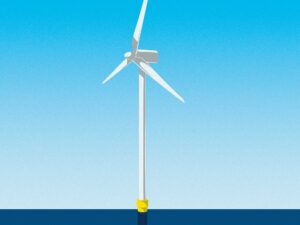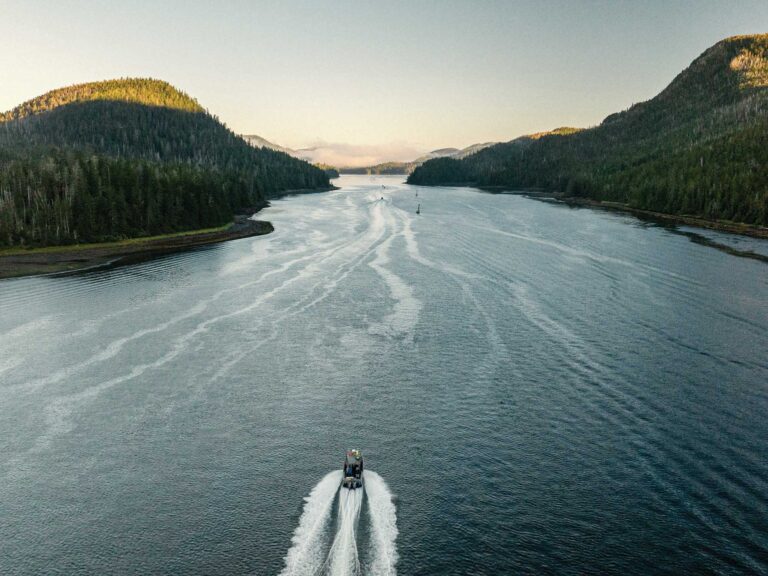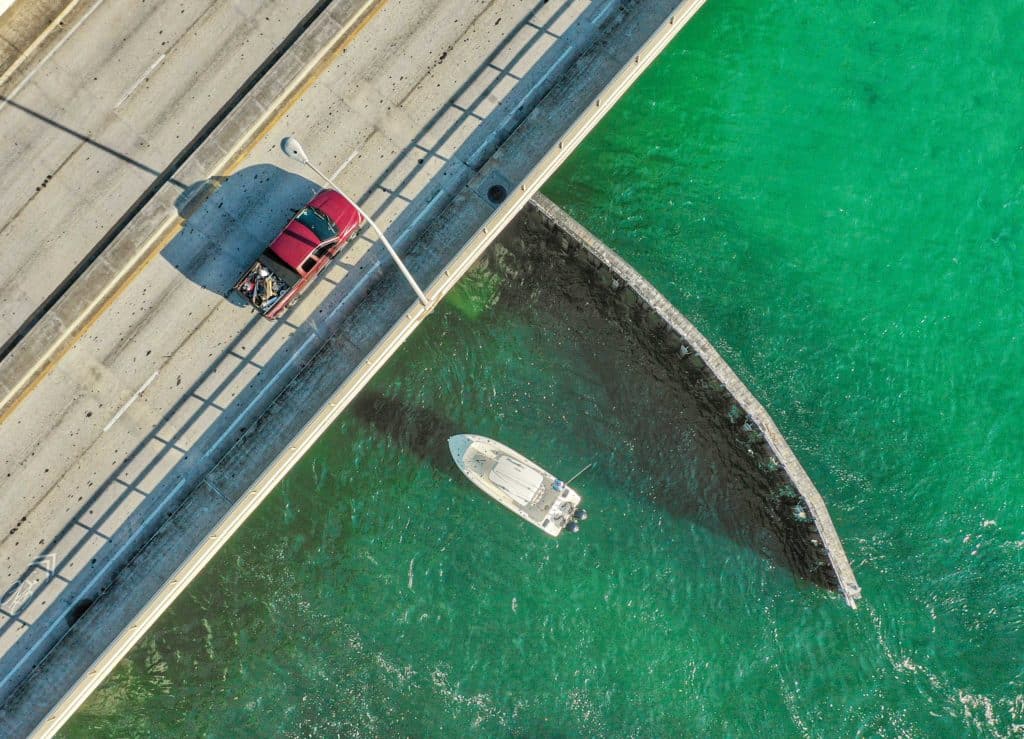
Imagining where it is easiest for predators to capitalize on forage is a solid basic strategy to catch more fish around bridges. But having the skill to safely fish tight to pilings, groins and seawalls, given strong tides, wind and boat traffic, will only improve your results and consistency.
Basic Targets
Pilings, stanchions and groins—and shadow lines at night—are major hotspots. Here, gamefish typically lie down-current, out of the main tidal flow, simultaneously ambushing bait and preserving energy. But it’s not always about the down-current side.
During early tidal stages, when current velocity is light, aggressive fish often hunt up-current of structure. When moderate and strong tides strike structure, a wedge of calm water forms around it. These wedges become ambush spots often occupied by larger fish. Even when a tide progresses and fish retreat down-current, these wedges are worth drifting a bait or bouncing a bucktail through.
360 Bonus
The first and last rows of in-line structures in inlet passages are subject to the full brunt of tidal flows, which create washouts or ruts on the down-current sides, and a second prime ambush spot.
During an opposing tide, fish lie in these ruts and feed, facing the current and conserving energy. These ruts also serve as ideal habitat for bottom dwellers like fluke, spot, drum, snapper and grouper.
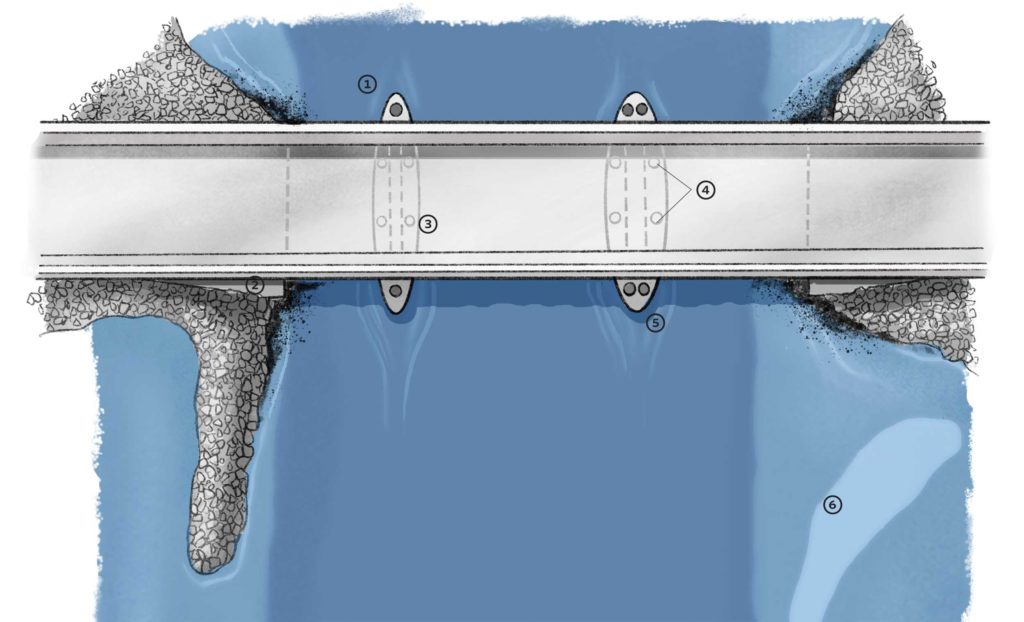
Pilings sandwiched between the end pilings are generally bolstered from tidal forces and less likely to form ruts. The bottom line: Identify these spots, and don’t limit your opportunities by fishing just one side during a tide.
Go Wide
Side-scanning sonar reveals promising bottom around pilings and the entire bridge environment. Any significant bottom dips, depressions, shelves or rock croppings are potential hotspots. Mapping out such spots is a big advantage for finding fish throughout a tide.
Long-Distance Relationships
Eddies and rips disorient and collect bait. The cushion of calmer water on the inside of an eddy and along a rip are prime stalking zones. Most eddies and rips form from tides washing through a bridge. However, based on the inlet makeup, these features may occur well down-current of a bridge, such as where the tide deflects off a seawall, or washes over a shelf or bar.
These spots are often overlooked, but I can vouch for the snook, tarpon and big jack crevalle they produce. What’s more, they’re great bailouts from a crowded bridge.
Bull Ring
Capt. Gavet Tuttle fishes north Miami-Dade’s Haulover Inlet, referred to as the Bull Ring, and his strategy translates to many other areas.
The velocity of the tide through this narrow, shallow passage, the boat traffic and the tight confines make it difficult to navigate, let alone fish. However, the bridge is a magnet for snook, tarpon, big jacks, barracuda, snapper and grouper.
“Slack tide here is actually a good time to fish the bridge,” Tuttle says. “Fish are roaming about, and it’s easy to explore both sides of the bridge and its stanchions.
“It takes less weight to place a bait in a strike zone, and the action of live baits and lures is less restricted. When the tide starts moving, fish begin feeding aggressively behind fenders, stanchions and bulkheads.
“I prefer the first half-hour of an incoming or outgoing tide, and fishing along the eddies on the back sides of these structures. There are some good bottom ruts here too. I’ll cast a live bait or pilchard-tipped bucktail up-current and let it drift through these zones.”
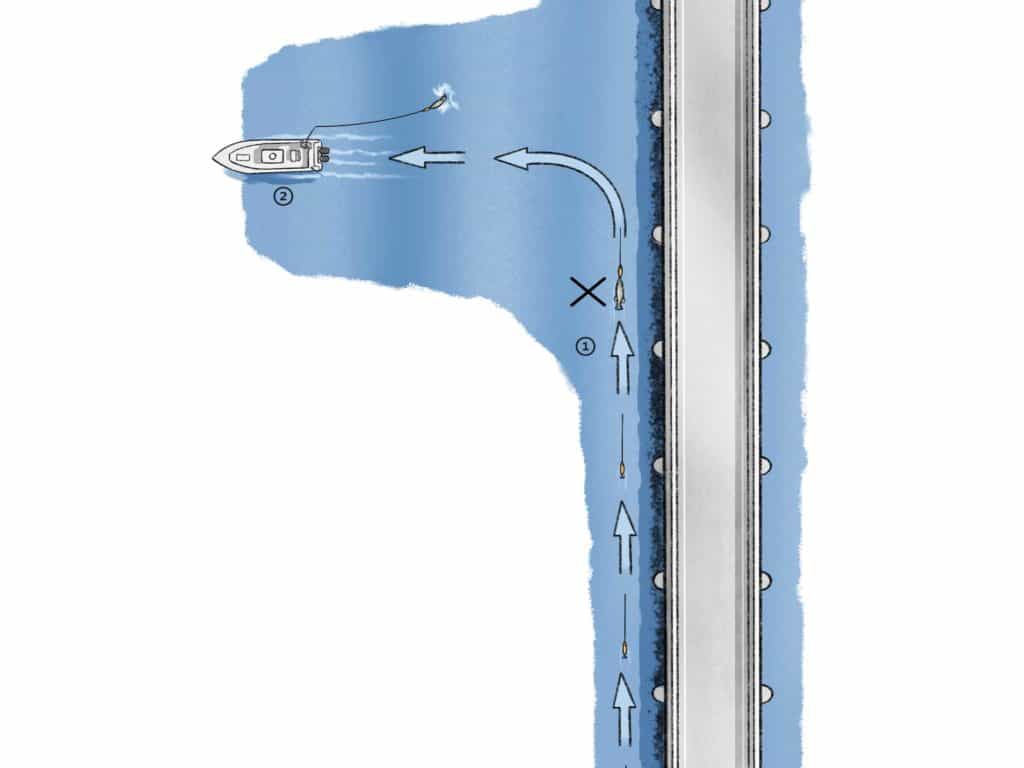
When the tide becomes too tough for soaking bait, Tuttle breaks out the diving plugs and trolls, concentrating on groins and stanchions. “Trolling is an easy way to fish Haulover and smaller bridges,” he says. “The plugs remain in the strike zone, and you can pull them by most parts of the bridge. Snook, tarpon, jacks and big ‘cudas love them.”
Bigger Playing Fields
The same fish-holding features apply to superbridges. Virginia Beach’s Dr. Ken Neill III is an authority on fishing the Chesapeake Bay Bridge-Tunnel.
“We concentrate on the up-current side of the bridge for striped bass,” Neill says. “As the tide progresses, teenager bass feed into the current until it becomes overbearing, then they look for relief behind the pilings.
“Trophy-class bass are lazy and apt to feed in the lee of the current. To target them, position the boat near the lee of a piling, stem the current to hold position, and send down a livey. It’s precision fishing, best saved for calm conditions.”
Neill goes on the troll when the tide becomes overbearing. “We’ll troll lures and swimming plugs, and parallel the up-current pilings,” he says. “It’s tricky, in that you want the lures to pass tight to the pilings, for the fish behind them, yet not close enough to snag the structures. With a strong tide and any wind, it can be challenging.”
Mobile Bay
Along the Dauphin Island Bridge, up-current spots are favored for seatrout. Capt. Patrick Garmeson targets them by floating back live shrimp and croakers. “I’ll make micro-adjustments on the floats to find the precise depth where fish are feeding,” he says. “Compared to redfish and flounder, trout move about more to feed. We catch a lot of redfish here on the back side of pilings, hunkered down and feeding on baitfish washing by.
“I prefer fishing along the tide changes. That’s when the flow is easy enough to thoroughly explore the bridge pilings. Once the tide grows stronger, even the trout retreat down-current for relief. My trolling motor is crucial for this type of fishing.”
Skillsets
Precision and safety go hand-in-hand. Tuttle recommends one person at the wheel, and one on the rod. “Holding a boat tight to a piling or eddy requires skillful use of throttles and steering,” he says. “I don’t suggest fishing bridges by yourself. But if you do, a GPS trolling motor could be a major asset.”
Teamwork goes beyond holding a boat in a tight spot. Once hooked up, the helmsman should motor away from the structure, into open water. It’s no different when trolling: Hook up underneath a bridge, and the helmsman best keep the boat moving forward until the span is cleared. Plugs are pretty expensive, and most of us know too well the sting of losing a big fish and the lure to a piling.

